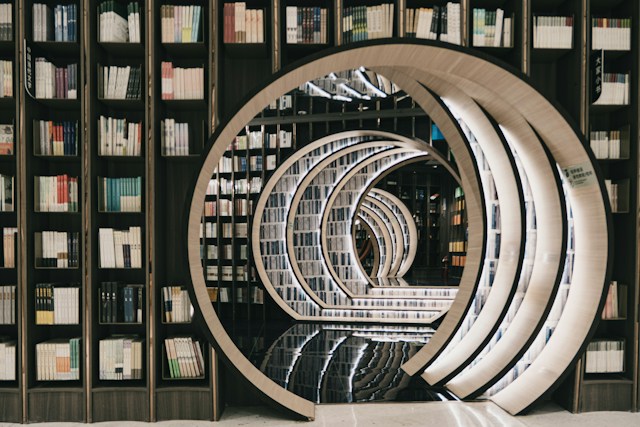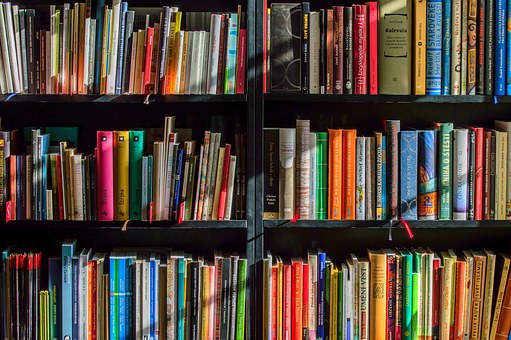Monday Moments: Writing As Literary Time Travel
Introduced By Amber Hall

This month, our theme continues to be ‘Beginnings And Endings’. I’ve been thinking about how we, as writers, have the power to play around with structure and turn the idea of beginning, middle and end on its head.
Writing gives us a lot of freedom and it’s easy to forget this, particularly when we first start putting pen to paper. We can transport the reader anywhere we like: to other worlds, real or imagined, and to other moments in time. Unconstrained by the laws of physics, we can be literary time travellers. In weaving together pasts, presents and futures, we can share our perspectives on the current moment, capturing the zeitgeist in an interesting way. Non-linear narratives are hard to pull off but, if done properly, these stories can have a big impact. Readers want to be challenged and getting creative with structure is one way to do this. Middles- or endings-as-beginnings make for memorable reads, so long as the timeline is clear!
As someone who writes a lot of personal essays and memoir, time is something I contend with a lot in my work. I’m always very aware of this from a technical perspective, and I think carefully about how things like tense and language delineates time and place. Much of my writing is sprung from memory, which means I often start with a series of mental snapshots, rather than a story outline. Usually, I have an essential idea I want to examine by bringing together my past and present. Memories, particularly childhood memories, have an intangible quality; like dreams, they bend time, and this is something writers can utilise or experiment with.
Retrospection is invariably clouded by the things we know now and, for me, that’s the interesting part. I don’t want to chase nostalgia; I want to take the reader on a journey, showing them how I got here – where the essential idea came from. When we retrace history, both personal and non-personal, we contextualise the present and shine a light on the here and now.
The pieces I’ve chosen for my page this month explore the idea of memory, time and place, and reveal the interconnectedness of these things from a literary standpoint.
*****
First, we have a prose piece by Claire Buckle, who explores the notion of literary time travel. In it, she provides examples whereby a non-linear narrative structure has amplified a text and its themes, noting how historical lenses can connect us to contemporary issues, using her own published work as a reference point.
The Magic Of Literary Time Travel
When we pick up a novel, we usually expect it to be a straightforward journey with a beginning, middle and end. However, some writers turn this chronological structure on its head, and become literary ‘time travellers.’ Sarah Waters’ The Night Watch, for example, introduces the reader to four Londoners in 1947 whose lives are linked by tragedy. Gradually events unfold, taking the narrative back through the midst of WWII, ending in 1940. Books such as these focus on uncovering a journey, not heading towards the destination, and break away from traditional narrative.
Other authors opt for fragmented timelines, mirroring the complexity of human experiences. Think about our dreams, perceptions and memories, which are rarely linear. One example of a book using this technique is The Time Traveller’s Wife by Audrey Niffenegger. Here, the male protagonist involuntarily travels back in time, meeting his wife at different periods of her life – from childhood to old age. It’s admirable, unconventional storytelling.
Scott Fitzgerald’s short story, The Curious Case Of Benjamin Button, tells the strange tale of how Benjamin’s life ages in reverse, whereas in the novel Time’s Arrow, by Martin Amis, the protagonist experiences time in reverse, with the story told backwards from death to birth.
When a writer has researched the past for a novel, it’s possible to connect it to the contemporary zeitgeist. I can illustrate this using my story A Brush From The Past, published in Woman’s Weekly Fiction.
Employing the structure of parallel timelines – the present and the 1800s – introverted art restorer, Will, cleans a grime-covered portrait, revealing a woman whose face is scarred from smallpox. The painting belongs to Caitlin, who self-consciously covers a facial birthmark with her hair. Will explains that it was rare for a portrait from that era to have shown the reality of scarring. Women would have used powder and pieces of shaped fabric to cover the scars. Similarly, in contemporary society, it’s the norm to cover scars, birthmarks, wrinkles, etc. with cosmetics. The story deals with love, resilience and truth, highlighting universal themes I hoped readers could identify with. Will and Caitlin connect through the timelessness of human experiences.
Well-crafted stories are immersive and can transport readers to new worlds. Genres like science fiction, fantasy, and magical realism are often more than pure escapism from the here and now; they are portals to alternative realities too, allowing the reader to experience another realm through narrative, but may also include metaphors for the lives we live today and provide a fresh perspective on a reader’s life. Philip Pullman’s His Dark Materials explores allegories and hidden meanings, tackling themes like combating corruption and overthrowing dangerous ideologies. As fantasy author Ryan Peabody notes: The very essence of fantasy is a metaphor for real life.
Regardless of the genre, bridging the gap between past and present involves identifying timeless themes and challenges. Why not consider submitting a story to a competition, starting at the end? There can’t be many written in that way. I might even give it a try myself!
© Claire Buckle, 2024
Connect with Claire on Instagram: @cloubuckle
*****
Next, Ray Miles writes about the literary legacy of Wordsworth, using memory and the senses to highlight history’s place in the present.
Lines Written On A Visit To Dove Cottage
I entered boldly through the door,
Anticipating all the thrills.
When I looked down, upon the floor,
I thought I saw some daffodils.
Not by the lake, or ‘neath the trees,
But oh! They all my senses please.
I felt the presence in the room
Of spirits that had once been here,
I caught a waft of old perfume,
And thought I heard a footstep near.
What lines were written in that chair?
Those which are beyond compare.
The joy that was his sister’s voice
Remains here still; she shared his views.
For in their love he did rejoice,
And from her words, he took his muse.
To be together was their dream,
The cottage was their common theme.
All this I think of when I lie
Upon my couch, and then I smile,
Because I see with inward eye
And nothing can that sight defile.
Yet still my heart with pleasure fills,
Because I saw those daffodils.
© Ray Miles, 2023
*****
Finally, we have a poem by Hongwei Bao, who shows us that memory and place are inextricably linked. Here, the first two stanzas – dream-like in their depiction of Prague and its cultural significance – are undercut by the poet’s lived experience. We are left with a sense of otherness as the present reality rudely impinges on an idealised past.
Lost In Prague
I’d heard your rolling waves in Smetana’s Vltava.
I’d touched your sadness in Kundera’s pages.
I’d tasted your Pilsner, that cold, refreshing liquid which reminded me
Of your mountains, your forests, your rivers, your springs.
Prague, I’ve come to you, to share your happiness, your joys.
A city where I frequently get lost in its labyrinth, greeted by delightful surprises.
A city where ornamental buildings house the city’s secret, too dark to uncover.
A city where cute muskrats chase people, begging for food, like ducks, like squirrels.
A city where rainbow flags brighten up the boulevard, even if just for a day, a week.
A city where the sun shines, water glitters, music flows, and heart sings.
Until a group of teenagers, pissed and stoned, shouted loudly
At me, in a foreign language I couldn’t understand, which reminded me
That I was a foreigner in this city. I ran, as fast as I could.
Through the labyrinthian alleyways.
Along the rainbow-coloured boulevard.
And under the blue, diamond-like Bohemian sky.
© Hongwei Bao, 2023
Connect with Hongwei on X: @PatrickBao1.
*****
Issue 19 of Write On! is out now and you can read it online here. Find it in libraries and other outlets. You can find previous editions of our magazines here.

You can hear great new ideas, creative work and writing tips on Write On! Audio. Find us on all major podcast platforms, including Apple and Google Podcasts and Spotify. Type Pen to Print into your browser and look for our logo, or find us on Podcasters.Spotify.com.
*****
If you or someone you know has been affected by issues covered in our pages, please see the relevant link below for information, advice and support:
Memories, particularly childhood memories, have an intangible quality; like dreams, they bend time, and this is something writers can utilise or experiment with.




